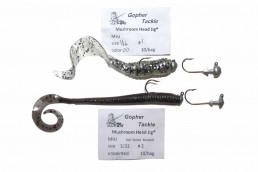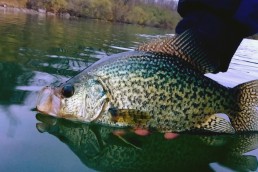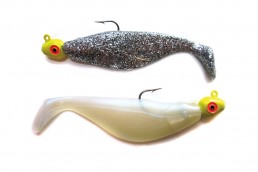What’s a ‘Shroom-head Jig and Why all the Fuss?
SHARE THIS POST
Todays’ assortment of jig heads is staggering. You could simply stick with the (ball) round-head jig, though they’re not perfectly suited for tubes and will hold one. Just about any artificial or live-bait offering can be rigged with this old favorite. They’re also appealing to the angler on a budget, offering reliable, consistent options.
The downside is the round-head jig catches weeds, and lessens the likelihood of quality largemouth catches during active periods. Despite this, ball-style jigs work consistently in other scenarios. If one gravitates toward other jig head designs the options are limitless. There’s the tube jig, “shaky” head, swimbait design, and so forth. You could amass half a dozen good-sized utility boxes full of jigs and not seem to scratch the surface. But finding the right jig head design on a body of water is paramount.
There is an extremely versatile jig head design that’s a documented catcher—the original Mushroom Head Jig by Gopher Tackle. It’s one of the most copied designs on the market and has been on the scene for decades. You can arguably rig this jig head with any plastic bait. This eliminates the fisherman’s dilemma of utility boxes packed with assorted jig styles. The truth is, the original Mushroom Head Jig really started all the rage, and for good reason. These have excelled for anglers pursuing everything from largemouths to smallmouths to walleyes and to crappies to white bass.
The implementation of the flatter, mushroom head-style jig paired with finesse baits for gamefish has grown substantially the past two years. This design has been around since the ’70s, but without going into particulars, I’ll will explain what makes this jig head “tick” for numbers of fish.
A substantial portion of the weighted part of the jig is slotted alongside the jig hook, as opposed to having a traditional “ball” head. It’s similar to the weighted design of a tube jig head except that you can fish a twister tail or minnow body with comparable rigging capability. Also, with a round-head jig you get almost a straight downward falling motion regardless of the plastic used. A tube jig head gives the tube a gliding motion; a mushroom head is a unique, patented combination that offers a falling motion. Regardless of what plastic is rigged, the fall is more of an undulating or rocking motion, greatly enhancing the amount of time your plastic is within a fish’s strike zone.
Are you enjoying this post?
You can be among the first to get the latest info on where to go, what to use and how to use it!
My favorite way to rig the Mushroom Head is on a grub inserted through the body seam (straight tail facing up or down) for a slight wobbling action or pushing the hook point opposite the seam for a slower fall (tail sideways).
Another venerable option is the Kalin’s Lunker Grub. I’ve seen many, ranging from twister-tail worms to slug or minnow styles. But in most cases you will want to use a knife to trim the initial portion of the plastic head for easier rigging.
For fishing the Mushroom Head, you would like any other jig, and there are several designs similar to the original with finesse-sized plastics dominating the trend in pressured waters. A tournament secret prior to the jigs’ resurrection was to fish a “jig worm” consisting of a worm casted to light cover and then freed from the snag with the quick snap of a wrist.
Time spent on the water fishing can be further streamlined through intuitive designs found on the Mushroom Head Jig, or similar variants. I now carry fewer jig heads and can bring more plastic baits. This makes me more comfortable and productive and I can amass more plastic body styles to experiment with. Less complication and more fish is always a good thing.
MWO
SHARE THIS POST
Did you enjoy this post?
You can be among the first to get the latest info on where to go, what to use and how to use it!
Frank Racz
With almost two decades of fishing retail knowledge, Frank Racz’s dedication to the “stitching technique” has led to a modern Midwestern largemouth bass variant and bluegill pursuits. He is avid about the techniques’ multispecies potential and other long spinning rod inquiries featured on his YouTube channel.



